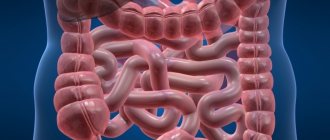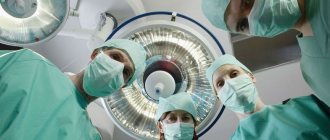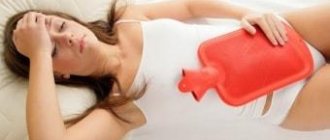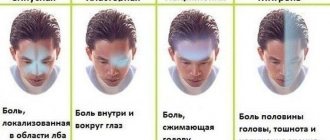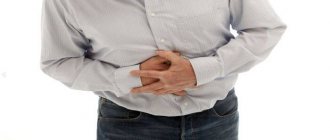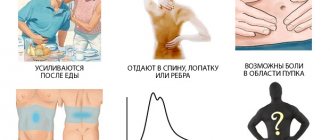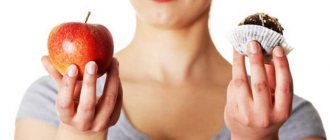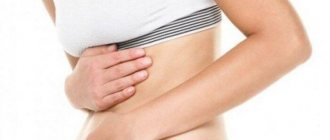Recently, the incidence of pancreatitis has increased significantly. This is due to the spread of fast food and the abuse of low quality alcohol. The peak incidence occurs in active working age from 30 to 60 years.
Acute pancreatitis is an inflammatory process that initially occurs in the pancreas and subsequently spreads to surrounding tissues and organs. It is difficult to diagnose early onset, therefore, despite modern medicine, the mortality rate with this diagnosis remains high.
To avoid serious consequences, we will consider in detail what acute pancreatitis is, its symptoms and treatment, and also tell you what preventive measures will help prevent its development.
Classification
AP classification is carried out taking into account the degree of progression of the inflammatory process, the presence or absence of complications. According to the form of the disease, it can be edematous type, sterile pancreatic necrosis and infected pancreatic necrosis. Sterile AP is further classified into limited and widespread type, and according to the nature of the lesion, the pathological process can be mixed, fatty and hemorrhagic.
Classification by severity:
- mild form (the disease is characterized by minimal damage to the pancreas and mild symptoms);
- severe form (extensive damage to the pancreas, severe symptoms, the presence of complications in the form of abscesses, necrotic areas).
Characteristics of the pathology
The main cause of pancreatitis is a blocked duct. This condition can be caused by neoplasms, gallstones, and other factors. When the duct is blocked, the process of gastric juice outflow is disrupted (the substance contains enzymes that protect the pancreas from negative effects). The pathological process provokes deviations in the functional state of the organ. Enzymes begin to act inside the gland, destroying its tissue. This process is accompanied by swelling of the organ and pain.
An attack of pancreatitis is a period of exacerbation of this pathological condition.
Symptoms
The main symptom of acute pancreatitis is a pain attack localized in the digestive tract. Spasms can be concentrated in the abdomen, right or left hypochondrium. An attack is triggered by a specific factor - eating fatty, spicy or fried foods.
If the patient takes a horizontal position, the pain increases significantly. Pain in acute pancreatitis is severe and constant.
Symptoms of inflammation:
- nausea;
- flatulence;
- uncontrollable vomiting;
- heartburn;
- vomiting of bile masses;
- cyanosis of the skin;
- signs of dehydration;
- repeated diarrhea;
- lack of appetite;
- yellowness of the sclera;
- hemorrhages in the navel area;
- feeling of heaviness in the intestines;
- sharp pain in the upper abdomen;
- excessive tension in the anterior abdominal muscles;
- increase in body temperature.
Clinical picture
Pancreatitis always begins acutely against the background of excellent health. As a rule, the development of pathology is preceded by the consumption of large doses of alcohol or fatty foods. Symptoms include:
- Pain. Painful sensations are localized in the epigastrium (with the development of inflammation in the body and tail of the gland), the left hypochondrium (with damage to the head of the organ), and in 40% of cases they are encircling in nature. The intensity can be anything: from weak to unbearable, forcing one to take a forced position (on the left side with bent legs and arms). The pain may radiate to the left arm, the left half of the abdomen and to the retrosternal space, clinically resembling myocardial infarction.
- Dyspeptic disorders. In 80% of patients, vomiting develops reflexively, which can be indomitable (up to 10 liters or more per day). This condition quickly leads to dehydration. After 2-3 days, due to enzyme deficiency and the development of intestinal obstruction, bloating appears and there is no stool.
- Peritoneal syndrome. The lesion involves the parietal and visceral peritoneum, which causes severe pain throughout the abdomen and a complete lack of intestinal function.
The general condition deteriorates sharply, weakness, physical inactivity, and irritability appear. Body temperature quickly rises to high numbers (39-40 degrees).
From the cardiovascular system, tachycardia develops (increased heart rate to 120 beats per minute), hypotension. The skin is pale, acrocyanosis.
Expert opinion
Shoshorin Yuri
General practitioner, site expert
In severe cases, an effusion of inflammatory exudate occurs into the pleural cavity with the development of pleurisy, pneumonia and pulmonary edema, leading to severe respiratory failure (increased respiratory rate to 30-40 per minute or more, shortness of breath).
A rapid increase in intoxication and hypotension leads to renal failure (the volume of urine excreted decreases, up to its complete absence).
When the central nervous system is damaged, mental disorders occur: agitation, anxiety, delirium, hallucinations. Further progression causes the development of coma.
Diagnostics
When symptoms of acute pancreatitis appear, it is necessary to carry out a differential diagnosis with acute appendicitis, intestinal obstruction, gastrointestinal bleeding and exacerbation of peptic ulcer. The clinical picture of the patient’s health status is compiled on the basis of complaints, external examination, as well as the results of laboratory and instrumental studies.
In some cases, a minimum number of examination procedures must be performed to confirm the diagnosis.
Laboratory and instrumental diagnostics
Instrumental and laboratory diagnostics are an integral part of the patient examination process. A general and biochemical blood test is mandatory. Additionally, special indicator tests are carried out. Instrumental diagnostic procedures are selected taking into account the general condition of the patient.
Types of laboratory and instrumental procedures:
test for amylase activity in blood and urine;- blood biochemistry;
- general blood analysis;
- ionogram (degree of dehydration);
- Ultrasound or radiography;
- CT or MRI;
- laparoscopy;
- angiography;
- EGDS.
Use of antibiotics
Recent studies have shown that antibiotic prophylaxis in patients with AP does not reduce mortality rates. Therefore, routine antibiotic prophylaxis is no longer indicated for all patients with acute pancreatitis [17].
Antibacterial therapy is recommended for the treatment of infected severe acute pancreatitis. However, diagnosis of infection may be difficult due to the clinical presentation, which may be similar to other infectious complications or to the inflammatory response caused by AP. In this case, measuring serum procalcitonin levels may help predict the risk of developing infected pancreatic necrosis.
Patients with infected necrosis should be treated with antibiotics whose spectrum of action includes both aerobic and anaerobic microorganisms.
Routine prophylactic use of antifungals is not recommended for patients with infected acute pancreatic necrosis, although Candida spp. occur in patients with infected pancreatic necrosis and indicate patients at higher risk of mortality.
As we said earlier, in the pathogenesis of AP, seeding of the tissues of the gastrointestinal tract occurs through the translocation of bacteria from the intestinal lumen, which causes infection of the digestive tract by microflora (E. coli, Bacteroides, Enterobacter, Klebsiella, S. faecalis, S. epidermidis and S aureus), which makes carbapenems highly effective, especially imipenem/cilastatin. In addition, quinolones, metronidazole and cephalosporins in high doses may be effective.
Assessment of the severity of the condition of patients with acute pancreatitis
When assessing the condition of patients with AP, doctors use special scales. The Ranson scale is considered one of the most effective. The system includes eleven criteria. The patient's condition is studied at the time of admission to hospital and forty-eight hours later. Each item is worth one point. If the patient has less than three points on the scale, then acute pancreatitis is assigned a mild form of the course. If there are complications on the rating scale, the result should exceed three points.
Ranson scale:
| On admission | 48 hours after hospitalization |
| ASAT > 250 IU/l | Fluid retention > 6 L |
| Leukocytosis > 16000/mm3 | Plasma calcium <2 mmol/l (<8 mg%) |
| Age >(60) 55 years | PaO2 < Hg Art. |
| LDH > 400 IU/l | Decreased hematocrit by more than 10% after admission |
| Blood glucose > 11.1 mmol/l (> 200 mg%) | Metabolic acidosis with base deficiency >4 mEq/L |
| Plasma calcium <2 mmol/l (<8 mg%) |
Intracellular enzyme activation
As mentioned earlier, the activation of trypsinogen occupies a central position. At the moment, the main role is assigned to cathepsin B, a cysteine protease protein found in human lysosomes. Normally, the Golgi complex does not allow the fusion of vacuoles with digestive enzymes and lysosomes, but in a pathological condition, sorting is disrupted and their fusion occurs. Cathepsin B activates trypsinogen inside the vacuole. It is unable to withstand aggressive contents and breaks. A large amount of activated trypsin appears in the cell matrix, which the defense mechanisms are unable to cope with. Activated trypsin leads to the formation of more trypsin from trypsinogen, as well as to the “switching on” of other pancreatic enzymes, such as phospholipase, chymotrypsin and elastase, and dysregulation of other enzyme cascades, including complement, kallikrein-kinin and fibrinolysis.
Is it possible to provide first aid for acute pancreatitis before the doctor arrives?
In case of AP, first aid should be provided to the patient. Correct measures will significantly alleviate the patient's condition. Before the ambulance arrives, it is prohibited to take enzyme preparations (Creon, Festal), eat food or use potent medications to relieve pain.
Some medications can mask the symptoms of the inflammatory process, and it will be more difficult to diagnose an attack.
First aid:
- applying ice or a cold compress to the area of pain;
- clothing should not interfere with the flow of oxygen into the lungs;
- the patient is provided with bed rest and complete rest;
- the patient should not take a horizontal position (reclining, on his side).
Video on the topic: First aid for pancreatitis (acute attack, pain).
What should I do to prevent the attack from happening again?
If you follow all the recommendations of your doctor, you can prevent a second attack. General rules:
- Don't forget! It is necessary to periodically apply cold compresses.
- Stick to fasting meals. It is best to drink weak tea and eat wheat crackers on fasting days.
- Get regular preventative checkups.
Now you know what the symptoms of an attack of pancreatitis are and how help is provided. But remember, as soon as an attack occurs, you should not delay treatment; it is better to consult a doctor.
Treatment
Therapy for AP is aimed at restoring the functional state of the pancreas, maximizing the load on the organ and relieving pain. Hospitalization and bed rest are recommended for patients with this diagnosis. Self-medication for this pathology should be excluded.
Improper therapy can cause complications (abscesses, necrosis), some of which are incompatible with life.
Conservative treatment
The treatment regimen for acute pancreatitis depends on the severity of symptoms and damage to the pancreas. Some methods of conservative treatment are mandatory regardless of the form of the pathology.
If surgery is indicated for the patient, then after surgery some points from the standard plan are used as restorative therapy.
Conservative treatment of AP:
- infusions of saline and protein solutions (to restore acid, protein, and water-electrolyte balance);
- detoxification therapy (Lasix);
- intravenous administration of drugs that accelerate microcirculation (Hemodez);
- creation of hyperthermic conditions (cooling compresses are applied to the source of pain);
- taking deactivators of pancreatic enzyme inhibitors (Gordox, Kontrikal);
- antibacterial therapy (to prevent complications);
- antiemetics (Regidron, Domperidone, Trimebutin);
- use of antispasmodics or novocaine blockade (for pain relief, Baralgin, Tramadol);
- treatment with antacids (Gastrozol, Phosphalugel, Almagel);
- taking medications to neutralize gastric contents (Pantoprazole, Omez);
- diet (fasting is recommended in the first days of an attack).
Antibacterial therapy for acute pancreatitis
The purpose of using antibiotics for acute pancreatitis is to reduce the risk of bacterial complications, stop the inflammatory process in the digestive system and prevent the spread of infection to other organs.
Taking antibacterial agents is allowed only if there is a doctor's indication.
Examples of antibiotics used for AP:
- Gentamicin;
- Ampicillin.
Surgery
Surgery is a radical treatment measure for AP. The main indications for surgical procedures are stones in the bile ducts, the presence of abscesses, cysts and necrotic areas on the pancreatic tissue. Surgery may be necessary if there is excessive fluid accumulation in or around the gland. After surgery, the patient is prescribed rehabilitation therapy.
Types of surgical procedures:
- pancreatectomy;
- necrectomy;
- endoscopic drainage;
- cystogastrostomy;
- Marsupialization of the cyst.
How long do the pain last and what is its nature?
The acute phase of chronic pancreatitis can be accompanied by painful attacks that have varying intensity, intensifying after eating, and stopping within 3-4 hours. If the diet is not followed, the pain can increase and the attack time increases. As a result, the patient requires hospitalization and inpatient treatment. If the pathology is ignored, abdominal pain will accompany the patient constantly.
Pain can occur from eating or from physical fatigue. Relief from pain comes with rest. Body position also influences the manifestation of pain. During exacerbations, it is difficult for the patient to sit; a feeling of a driven stake appears in the stomach and back. Pain occurs of various types:
- aching;
- pulling;
- piercing;
- drilling;
- spicy;
- stupid.
Disturbance from them can last for weeks. The duration of the attack depends on how much the gland swells or on the area of necrosis.
With timely assistance, pain relief occurs quite quickly, and a painful attack can be relieved within a day. In case of complications and dangerous development of the situation, it can last up to three days. Depending on the duration of the painful attack, pancreatitis can be divided into the following types:
- type A. With this type of painful attack, the pain lasts 7-10 days, the exacerbation phases are replaced by phases of “calm”;
- type B. This type of pain lasts from one to three months. Usually characteristic of alcoholic pancreatitis;
- incessant pain. Requires surgery.
Any type of pain due to pancreatitis requires immediate pain relief.
Rehabilitation at home
The duration of hospitalization for AP depends on the form of the pathology and the general clinical picture of the patient’s condition. After discharge from the hospital, it is recommended to follow certain rules and change your lifestyle. If pancreatitis has been detected in a mild form, then some restrictions are gradually lifted. In case of severe disease and complications, the patient must adhere to the drawn up plan of recommendations throughout his life.
The basis of home rehabilitation is proper nutrition and the elimination of factors that can provoke a relapse of the attack.
Diet for patients
Fasting is recommended on the first day after the attack has stopped. The patient is provided with complete rest and parenteral nutrition. On the second day you are allowed to drink alkaline water. You can eat food from the third day (in severe cases - from the fifth). The diet should be expanded gradually. Allowed foods include pureed porridge (semolina, rice), vegetable broth, and low-fat white fish.
If there is a tendency towards recovery, you can add vegetables, fruits and dishes prepared in accordance with the doctor’s recommendations to the menu.
General diet rules:
- You can consume up to 6 g of salt per day;
- meals should be fractional (meals 5-6 times a day, the size of one serving should not exceed 300 g);
- Fatty, salty, spicy and spicy foods are excluded from the diet (even a single use of such foods can provoke an attack of AP);
- The basis of nutrition is vegetarian food (vegetables without coarse fiber, non-acidic fruits, seafood);
- Fresh vegetables, eggs, sausages, kefir, whole milk, alcohol, and strong coffee should be excluded from the patient’s menu.
Consequences and complications
During the inflammatory process, there is a risk of infection of pancreatic tissue with pathogenic bacteria. The consequence of their vital activity will be necrosis of pancreatic tissue and the formation of abscesses. A state of shock can be an addition to the inflammatory process. The combination of such complications in the absence of adequate therapy poses a threat to the patient's life.
Complications:
- pseudocysts;
- fibrous-purulent peritonitis;
- parapancreatic infiltrate;
- arrosive bleeding;
- septic shock;
- ascites (abdominal dropsy).
Prevention
Primary prevention of acute pancreatitis is to follow the rules of a healthy lifestyle. The diet should contain a minimum amount of fatty, fried and spicy foods (it is recommended to completely avoid such foods). Smoking and drinking alcoholic beverages increase the risk of digestive system diseases. An attack of acute pancreatitis is provoked by the listed factors. These rules apply not only to primary, but also to secondary prevention of pathology.
Prevention measures:
- compliance with the rules of a healthy diet (harmful foods, overeating and irregular food consumption are excluded);
- the body must receive sufficient physical activity (if work activity involves a sedentary lifestyle, then it is recommended to do basic exercises in the morning);
- weight control (sudden weight loss, excess weight can cause abnormalities in the functioning of the digestive system);
- timely diagnosis and treatment of any symptoms of digestive tract dysfunction (if gastrointestinal diseases are identified, then examinations by a gastroenterologist should be carried out at least once every six months);
- eliminating alcohol abuse, smoking and other bad habits.
Main causes of pathology
The causes of pancreatitis in some cases remain unclear, but attacks of the inflammatory process are always caused by specific factors. The main ones are alcohol abuse and poor diet. These factors can disrupt the action of pancreatic enzymes in a short period of time (especially if the digestive system is impaired by concomitant diseases).
Other causes of PP:
- malignant tumors in the pancreas;
- advanced gallbladder diseases;
- consequences of post-traumatic syndrome;
- nervous exhaustion of the body;
- excessively high cholesterol levels;
- infectious lesion of the digestive tract;
- regular intoxication;
- complications of operations on the digestive organs.
Why does an attack of pancreatitis occur?
Patients diagnosed with pancreatitis should follow a healthy diet. Even a single use of prohibited foods can provoke PP. Poor diet and alcohol consumption are the main causes of exacerbation of the disease.
There are also additional provoking factors that can shorten periods of remission. Their exclusion is the main measure for the prevention of pancreatitis.
Provoking factors:
- binge eating;
- drinking alcohol;
- reaction to certain medications;
- eating fatty, spicy, fried, salty foods;
- consequences of food allergies.
Forecast
Prognosis for acute pancreatitis depends on the stage of inflammation and the presence of complications. If the disease was identified in the early stages of development, and therapy was carried out in a timely and complete manner, then the patient has a chance of a complete recovery. When complications occur (especially with necrotic lesions of pancreatic tissue), the risk of death increases. Therapy in such cases should be carried out as early as possible and under the supervision of a physician.
Video on the topic: The first signs of pancreatitis that cannot be ignored!
Diagnostic methods
Successful treatment of pancreatitis often depends on accurate and early diagnosis. Primary diagnosis must be carried out within the first 2 days from the moment a person is admitted to the surgical department with suspected pancreatitis.
The “gold” standard for identifying a disease is the presence of a triad of symptoms in the patient:
- Severe pain in the gastrointestinal tract that radiates to the back.
- Frequent vomiting.
- Bloating or muscle tension in the area.
Collecting complaints and palpation helps the specialist make a preliminary diagnosis. By collecting anamnesis and palpation, the doctor makes a preliminary diagnosis. To complete the diagnostic picture, the following research methods are prescribed:
- laboratory tests (blood, urine, hemostasiogram);
- Ultrasound of the pancreas;
- X-ray of the peritoneum and chest;
- FGDS.
Sometimes it is necessary to take a tissue sample from the pathological area for histological examination. In this case, the doctor may recommend diagnostic laparoscopy.

